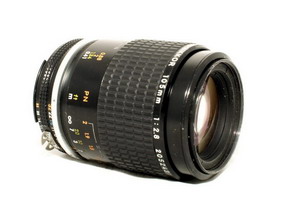Nikon Micro Nikkor 105mm f/2.8 AIS Lens Review |
|
What can I say about this lens superb ? Outstanding ? Perhaps these are the right words, I suppose every body expect phenomenal quality from a professional level Nikkor lens. You won't be disappointed! Exceptional good lens from every point of view , very well built mechanically and optically both. I didn't see any weakness of this lens, photography really a joy , easy to focusing , produce laser sharp superb colored images.Slightly better lens than other famous companies like Tamron SP 90 or Kiron 105mm f2.8. Sure this is very subjective opinion.
Fact Sheet
User Comments
(Bjorn Roslett,Naturfotograph.com) There are two manual focus 105mm Micro-Nikkors, an f/2.8 and an f/4.0. You should consider both. The 105/2.8 AIS Micro makes a good general purpose 105 and macro. As for the change in focal length I estimated 92mm for the 105/2.8 Micro but the lenses has CRC and change in focal length seems complex. Notice the free working distance of the 105/4.0 v. 105/2.8 at 1:2 and 1:1. The 105/4.0 AI or AIS Micro-Nikkor is probably the better and certainly the easier lens to use for serious close-up and macro photography. (David H.Hartman)
I did not like the 105mm f4 Micro-Nikkors I have tried - the 105mm f2.8's seemed better to me throughout their ranges. As for the 105mm MF Micro's CRC, if you use the lens at 1:1 on a tube, the CRC is nearly optimally set. As you approach 1:2 using a tube, the CRC approaches the infinity setting, but the lens is still good stopped down. (You might want to check out my "SLE(MN)" again....). Finding a lens that is great from 2x (with tubes, converter, or achromat added) to infinity at wide apertures is pretty difficult. The Nikkor 105mm f2.8 Micros (both MF and AF) come close, though each has a few compromises. (If very-close to medium distance performance and ease-of-use is more important to you, take the AF version; if moderately-close to infinity work is more important, take the MF version; if 6' to infinity is all you require, save money and take the 105mm f2.5). BTW, I would consider the 105mmm Micro's to be noticeably sharper than the 105mm f2.5 at 4-5' at wide apertures, though you may want the slightly reduced sharpness of the f2.5 at that distance for portraits.
If I have to make an order between my macro and macro purpose lenses I make this very subjective order.
Fast maximum lens speed also provides a brighter viewfinder image where often users complain the previous slower version has caused darkening of the split-image rangefinder in a standard K-type focusing screen in particular when working with a close-up attachment units or with PN-11 at its closest focusing distance. The lens can be focused down to a minimum distance at 0.47m (1.55ft.) to reach for a reproduction ratio of 1:2 half-life-size magnification. Similar to the slower f/4.0 counterpart, it uses a same PN-11 Auto Extension Ring to enable to almost * 1.0X magnification, that is at a minimum focusing distance at from 0.41sm (1.4ft.). {mos_ri:macro,micro,Tamron SP 90,Nikon,Nikkor} Tags: |

